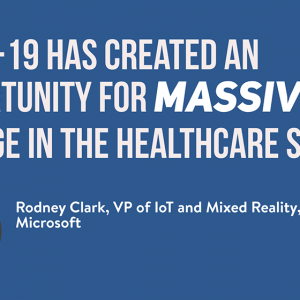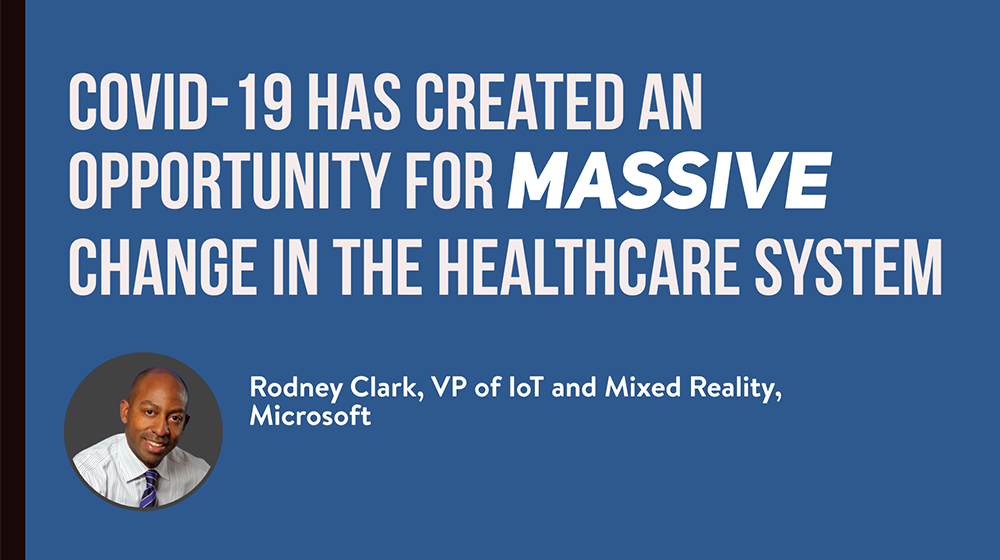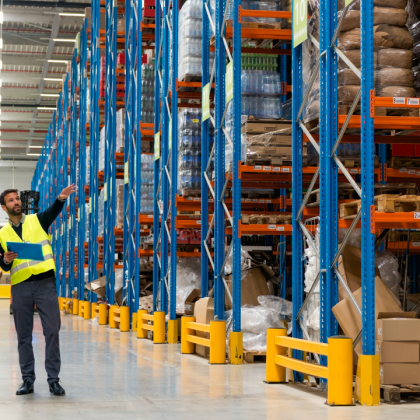Feature your business, services, products, events & news. Submit Website.
Breaking Top Featured Content:
Rodney Clark of Microsoft: COVID-19 Creates Opportunity to Massively Change Healthcare System


COVID-19 has stretched the American healthcare system to its limits, and beyond. And things are changing in real-time in order to deal with a pandemic that has already cost more than 87,000 people their lives in a span of just over two months. And technology is at the heart of that change as IoT and mixed reality devices are enabling telemedicine to dramatically increase, and the manufacture of ventilators to ramp up to produce numbers in months that typically take several years to push out.
Microsoft has been involved in developing IoT and mixed reality technologies for years. And during a recent LinkedIn Live conversation with Rodney Clark, VP of IoT Devices and Mixed Reality for Microsoft, I had a chance to learn how these technologies are being used during the pandemic to help the healthcare system meet the needs of patients and caregivers fighting the virus. Rodney also gives us a glimpse of how IoT and mixed reality devices will change other industries well after the pandemic is over.
To hear the full interview click on the embedded SoundCloud player.
And below is an edited transcript of our conversation.
Small Business Trends: How has IoT evolved over the years?
Rodney Clark: For more than 30 years now, we’ve been providing and supporting these fixed purpose devices with our Windows Embedded operating system. You go back to the early days of CE and some of the HP handhelds. You go back to some of those industrial scenarios with Beckhoff and Siemens that we’re really looking for runtime or near runtime scenarios to actually manage and to control some of their industrial devices. Well that business matured over years. When I stepped into the role, what we started seeing is that more and more of those embedded systems were talking to each other machine to machine, communicating critical data and information. Sensor Fabric started to develop and we started getting into heavier compute gateways that can aggregate a lot of that data and information.
When we saw that we said, look, if machine to machine is now, because of connectivity, a reality, then we should be in a position to extend data platforms with the same customers and partners that we’ve been building these embedded systems with. At about that same time in our company, we developed something as part of our Azure core services called the intelligence system service, which was as simple as an SDK on an Edge device that facilitated machine to machine that then got you into a broader set of data services.
From there, Azure IoT was born and we started investing and accelerating the set of services, getting to Ingestion Engine, things like Azure IoT hub, getting into IoT Central, Simple Device Management, scenario and solution cloud-based. From our perspective, with simple machine to machine as cloud and connectivity, businesses started to grow and accelerate; we started to see that specific need for data rich, data intensive environments coming from the Edge, and then building a set of solutions and capabilities that can help you interpret and analyze that information.
And so that’s, what’s happened over the last six years. And in that same time, we’ve gone from selling bits and pieces to partners and customers to building solutions with them.
Small Business Trends: What’s mixed reality? Where does that fit in?
Rodney Clark: For us, it is a way to accelerate and enhance human capabilities. It’s a way to visualize data and enact and interact with the environment in ways that feel extremely human, extremely natural. This isn’t a virtual setting. This is you’re in, and you’re manipulating objects. You know, things like object rendering, object recognition, we have a service in spatial anchors where you can really create a space and you can go back into and you can anchor objects in that space and you can go in and you can manipulate them with dexterity with one hand to hand. So this notion of mixed reality and then everything that HoloLens brings on top of that as a hero device has in essence created this business opportunity that we see. And again, there are peer definitions of mixed reality, but for the sake of this conversation, I’ll stop there.
Small Business Trends: I’ve seen where a smart thermometer company was able to use the data coming from their customers to locate potential Covid outbreaks by identifying spikes in temperatures in geographic regions. How is Covid-19 impacting the adoption of these technologies?
Rodney Clark: Let me start with the thermometer example. And then I’ll tie it in even to the mixed reality solution in scenario. I think in every case, COVID has created an opportunity for massive change in the healthcare system. We’ve seen ventilator production in the last three, four months that is worth traditionally seven, eight years in terms of volume. There was this ventilator challenge in the UK, which is a consortium of major UK industrial technology and engineering companies across all sectors like aerospace automotive, including medical. The HoloLens was actually used along with a set of absence scenarios to create and capture training. This guided workers and had an instruction set on how to basically produce the ventilators and then ultimately install them through the use of something like guides or PTCs, euphoria expert capture.
Tying it into your mixed reality statement, Dynamics 365 Remote Assist, is a big part of that. Dynamics 365 Guides in terms of training modules is a big part of that. What it did is it enabled those tools, as well as this mixed reality device, the manufacturing or the acceleration of these ventilators. Now, if I connect that to the thermometer solution and scenario, what you will see and what we have seen in working with partners, GE is a great example, another one where we accelerated ventilator production and then we also through a cloud and data platform enabled them to better see and monitor patient data and information. So they could start to aggregate trends, they can start to recognize some of those anomalies and they can treat more effectively in the hospital that extends and will extend into telemedicine.
Think about the edge points, the ability to collect and leverage that information and data, share it in a secure way that incorporates all the elements and aspects of privacy. That’s what IoT is bringing and delivering from the manufacturing of those devices and making sure we have the secure, connected endpoint along with the patient experience, be it an app on the phone or some other tool that you would log into from the hospital, and then ultimately that care provider being able to manage that information and data while protecting privacy. Those are the types of scenarios that are being accelerated because of COVID-19.
Small Business Trends: What do you think the other side of the pandemic is going to look like after we get through it?
Rodney Clark: Again, I’ll do a healthcare scenario. We have a partnership with PCL construction company and also data company. They’re now a software company in addition to what they’ve done traditionally, as well as Insight, it’s a portable care unit. And today it’s used in healthcare, which has basically an old shipping container. That’s retrofitted into a station where they can test people securely. And so think of a line forming and being able through thermal sensing to detect temperature of someone in line and being able to have kind of a pre diagnosis before they actually get up to the window that could also manage social distancing so that they can record and take information on whether or not that’s a potential cause.
So take that solution and just extend that to entertainment venues. What’s a large stadium? when you go and see your beloved Rams and you go and walk into the stadium where there are thousands of people, wouldn’t you want to see in the future, some type of scenario where they are doing some level of monitoring of that minimum temperature. So that that portable solution actually extends into entertainment. It might extend into retail scenarios. That forever changes how we do things.
Retail also will just forever be impacted and affected by this, that traditional retail. We are getting asked questions on, “Hey, how do we take that same in store experience and create data rich environments online?” Now there are companies who have mastered this as it relates to analytics, but now how do I personalize that to Rodney Clark or Brent Leary? Because now that’s the opportunity that I have and how do I leverage if a consumer opts in their information that they’re able to share with me to create that experience? That’s another significant change.
I’ll do two more really quickly. Cashless. Oh my gosh, half of the world is cashless and we’re not, we’re going to see an acceleration of cashless as well as no touch retail. And so you have a stores like Kroger or Target that have relied for years on the NCRs, or you have ATMs that will just be different experiences now that allow you to engage and interact with voice with gesture through coding and IoT is at the foundation of all of that, because it’s that interaction with an end point and it’s the management of the data, the analytics and the information.
There are other really impactful scenarios. One last one I’ll talk through is a smart city and ultimately how we will manage ourselves in this post COVID world. Now, this one is tough because there’s a lot of privacy concerns with it, but you do want to manage how crowds gather and where they gather over time. And you want to be able to create safe spaces for people to do that. And one of the ways to do that, there are two… There’re many ways, but one of the ways to do that is just to is through data and information and using data and information to create more of those spaces and spreading out where maybe there’s one park in a two kilometer radius, maybe it provides the traffic flow that’s being collected from cameras.
Maybe it provides the city an opportunity to put in another park in that same 2k radius. Smart grid and smart energy management. Hey, we’re all at home and I am tapping the heck out of my grid. Right? Right now and I’m not sure if we lost connectivity on wifi, because this is a popular time in my house. Everyone’s online but look the lights are on AC is going to be on for longer during the day. And so we’re getting a lot of requests as well from cities around how to basically manage their grids and some of the technologies that we use to do that. So there are a number of areas that will forever be impacted and affected by this.
Small Business Trends: Give us what you think companies should be doing now in order to prepare for when we do get past this and be in a position to take full advantage of some of the things that we’re talking about.
Rodney Clark: I’m going to answer this, Brent, from the two points of view and perspectives. One is from a Microsoft perspective and when I say Microsoft in this case, I mean companies that can help small businesses and other enterprises and overall communities kind of snap back to normal. And then I want to give some guidance to those companies. If I think about a company’s responsibility, there’s a community support that we all have to lean in on, there is remote working support. We’ve got to make sure that we are supporting our families who have a burden on educating children. And again, this notion of work from home doesn’t mean work all the time. There’s a ton that we can be doing to lean in on these data systems and solutions and providing that tech expertise that allows these companies to take the next step.
Rodney Clark: I think that acceleration out of this is about digital transformation. We already have a shortage of data scientists because of these nontraditional tech companies that have taken on this notion of being software and services companies on their own. We have a lot of companies out there that need help through this DT, this digital transformation journey, and then where you can, and you’ve seen a lot of companies lean in on the research aspect and really getting behind cures be they preventative or diagnostic. And so we’re companies can do that we should do that. So, those are kind of like the super high level, like how we come out of this together.
I think we also, and this is now kind of guidance and advice to those who were in the retail space to those who are in manufacturing to those who are planning the smart cities. You have to think beyond where we are currently. And if you want to differentiate, you have to think about the experience that you want to provide your consumers, your customers, that stadium experience is a great example, we’ve got the Seahawks stadium here, I won’t mention it because it would be a plug for a brand.
They need to be thinking about how they are going to make every single participant, every single customer that comes through those Gates feel safe. If you’re in a retail environment, you’ve got to think about this cashless, no touch experience. Our commercial real estate companies have to think about how they manage their tenants and their business portfolios and profiles moving forward.
So the thing that every company can do, and by the way, these… I really have been impressed with a lot of these event management companies. You and I were talking a little earlier about how much you spend on… time, you spend on the road and going to these live events. Wow. Has it not forced these traditional experiential companies to get really focused on online and virtual, that’s seeing around corners. And if there is not a natural process to slow down and do that planning for companies in all industries, especially for those who are small and midsize, who probably think they don’t have the time to do it, this is the time to do it. That’s how we come out of it.
When you get to a point where you’re asking questions and you don’t have the answers, then that’s when you turn back to the Microsofts of the world to help you with the kind of four or five things that I laid out previously. So super lofty answer, but it’s not a simple one. I know and I want your audience and these companies to know that we’re here to help. rodneyc@microsoft.com. If there’s anything that I can do, any way that I can put you in contact to help you be successful on this new wave, this next wave, then I’m all in.
This article, “Rodney Clark of Microsoft: COVID-19 Creates Opportunity to Massively Change Healthcare System” was first published on Small Business Trends


